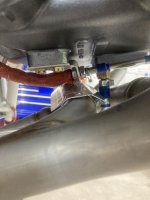claycookiemonster
Well Known Member
Laying out control cables forward of the firewall, and I blithely assumed I'd slip some firesleeve over one of cables that approached the exhaust pipes. Imagine my surprise to find that 1/2" ID was the smallest firesleeve available! My McFarlane control cables are 5/16" in OD. How do I protect them? There doesn't seem to be anything for such a small hose.





